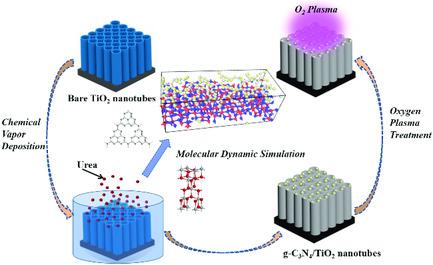当前位置:
X-MOL 学术
›
Energy Technol.
›
论文详情
Our official English website, www.x-mol.net, welcomes your
feedback! (Note: you will need to create a separate account there.)
Efficient Photocatalytic Degradation of Pharmaceutical Pollutants Using Plasma‐Treated g‐C3N4/TiO2
Energy Technology ( IF 3.6 ) Pub Date : 2020-04-30 , DOI: 10.1002/ente.202000095 Rui Liu 1, 2 , Lizhi Sun 3 , Yingjie Qiao 1 , Yongchao Bie 2 , Peng Wang 1 , Xiaohong Zhang 1 , Qiang Zhang 4
Energy Technology ( IF 3.6 ) Pub Date : 2020-04-30 , DOI: 10.1002/ente.202000095 Rui Liu 1, 2 , Lizhi Sun 3 , Yingjie Qiao 1 , Yongchao Bie 2 , Peng Wang 1 , Xiaohong Zhang 1 , Qiang Zhang 4
Affiliation

|
A series of oxygen plasma–treated g‐C3N4/TiO2 nanotubes are prepared, which exhibit excellent photocatalytic performance for degrading pharmaceutical pollutants under simulated solar light irradiation. The structure and optical properties of photocatalysts are characterized using scanning electron microscope, transmission electron microscopy, X‐ray diffraction, UV–vis, atomic force microscopy, and X‐ray photoelectron spectroscopy analyses. The g‐C3N4 nanoparticles are coated on the surface of TiO2 forming a heterojunction structure, which extends the light‐absorption region and inhibits the recombination of electrons with holes. Ibuprofen is used as a model pharmaceutical pollutant. The heterojunction structure allows the g‐C3N4/TiO2 high photocatalytic efficiency that is two times larger than that of TiO2 nanotubes. The efficiency of g‐C3N4/TiO2 is further enhanced by oxygen plasma treatment. The oxygen plasma–treated g‐C3N4/TiO2 exhibits a photocatalytic efficiency of 95% within 90 min, which is much larger than that of TiO2 nanotubes (28%), g‐C3N4 (52%), and g‐C3N4/TiO2 nanotubes (70%). The kinetics of the photocatalytic degradation are also investigated. The plasma‐treated g‐C3N4/TiO2 exhibits the largest rate constant, which results from massive surface‐active species and surface oxygen. Finally, the structural evolution and reaction mechanism are investigated using molecular dynamics simulations, which offer a deep insight into the photocatalytic reaction.
中文翻译:

使用等离子体处理的g-C3N4 / TiO2高效降解药物污染物
制备了一系列经氧等离子体处理的g-C 3 N 4 / TiO 2纳米管,它们在模拟的太阳光照射下表现出优异的光催化性能,可降解药物污染物。使用扫描电子显微镜,透射电子显微镜,X射线衍射,UV可见光,原子力显微镜和X射线光电子能谱分析对光催化剂的结构和光学性质进行表征。g‐C 3 N 4纳米颗粒被涂覆在TiO 2的表面上形成异质结结构,该结构扩展了光吸收区域并抑制了电子与空穴的复合。布洛芬被用作典范的药物污染物。异质结结构使g‐C 3 N 4 / TiO 2的光催化效率高出TiO 2纳米管的两倍。氧等离子体处理可进一步提高g‐C 3 N 4 / TiO 2的效率。经氧等离子体处理的g‐C 3 N 4 / TiO 2在90分钟内的光催化效率为95%,远大于TiO 2纳米管(28%),g‐C的光催化效率。3 N 4(52%)和g‐C 3 N 4 / TiO 2纳米管(70%)。还研究了光催化降解的动力学。经过等离子体处理的g-C 3 N 4 / TiO 2表现出最大的速率常数,这是由于大量的表面活性物质和表面氧所致。最后,利用分子动力学模拟研究了结构演化和反应机理,为光催化反应提供了深刻的见识。
更新日期:2020-07-02
中文翻译:

使用等离子体处理的g-C3N4 / TiO2高效降解药物污染物
制备了一系列经氧等离子体处理的g-C 3 N 4 / TiO 2纳米管,它们在模拟的太阳光照射下表现出优异的光催化性能,可降解药物污染物。使用扫描电子显微镜,透射电子显微镜,X射线衍射,UV可见光,原子力显微镜和X射线光电子能谱分析对光催化剂的结构和光学性质进行表征。g‐C 3 N 4纳米颗粒被涂覆在TiO 2的表面上形成异质结结构,该结构扩展了光吸收区域并抑制了电子与空穴的复合。布洛芬被用作典范的药物污染物。异质结结构使g‐C 3 N 4 / TiO 2的光催化效率高出TiO 2纳米管的两倍。氧等离子体处理可进一步提高g‐C 3 N 4 / TiO 2的效率。经氧等离子体处理的g‐C 3 N 4 / TiO 2在90分钟内的光催化效率为95%,远大于TiO 2纳米管(28%),g‐C的光催化效率。3 N 4(52%)和g‐C 3 N 4 / TiO 2纳米管(70%)。还研究了光催化降解的动力学。经过等离子体处理的g-C 3 N 4 / TiO 2表现出最大的速率常数,这是由于大量的表面活性物质和表面氧所致。最后,利用分子动力学模拟研究了结构演化和反应机理,为光催化反应提供了深刻的见识。











































 京公网安备 11010802027423号
京公网安备 11010802027423号